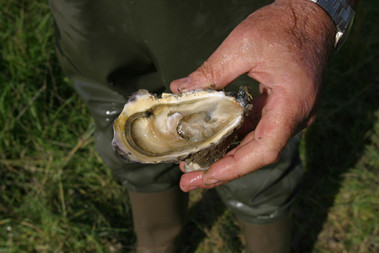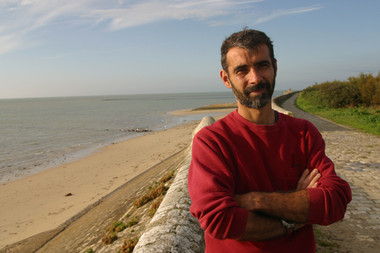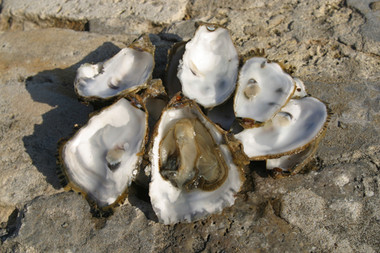Indulging oyster lovers with a sea of change in paradise
December 24, 2006 - The Santa Fe New Mexican

SAINT-CLÉMENT-DES-BALEINES, France— Nothing announces the arrival of fall in France like the sight of a perfectly dressed, slightly older women sitting alone in a PariÂsian café, eating a plate of oysters and drinkÂing a glass of champagne. Come the holiday season, the daintiness goes out the window and Frenchmen slurp them like they’re going out of style.
The French love oysters and the bivalves are big business here. At family gatherings on Christmas Eve, it’s not uncommon to see the dinner table nearly obscured under a mountain of the mollusks that will quickly disappear after midnight mass.
For better and for worse, raising and harvesting oysters in France remains a truly artisanal industry. Riding a bicycle along the coast, watching the oystermen at work, it’s easy to imagine you’ve gone back in time.
However, a recent crisis where two people died after eating supposedly tainted oysters (the bivalves were later acquitted), is pushing one of the few forward-thinking pioneers in the French oyster indusÂtry into the spotlight.
The Ile de Ré, an island off the western coast of France that is a beautiful mix of tourism and local industry, is also a strong representative of how oysterÂmen are slowly embracing change.
 Ile de Ré resident Patrick Benoit inhales one of the oysters he raises as a hobby. Photo by Joe Ray
Ile de Ré resident Patrick Benoit inhales one of the oysters he raises as a hobby. Photo by Joe Ray“The profession was hostile toward me 20 years ago,†began Eric Marissal, “ but now they’ve come to accept the idea that modernization is necessary.â€
Along with being a regional representative for the French shellfish farmers’ committee known as the CNC or le Comité National de la Conchyliculture, Marissal also runs Grainocéan, where he both raises baby oysters and has developed a non-“milky†version of the celebrated bivalve.
“Neolithic man eventually domesticated everything except oysters and mussels,†said a clearly perplexed Marissal reflecting on the relative lack of progress in his industry.
At first glance, his argument almost comes across as being contradictory. France is an oyster-lover’s paradise and from the consumer’s standpoint, there seems to be a lot of variety. A market fishmonger might have bins filled with six sizes of oysters for his customers to choose from, but that choice essentially boils down to a lot of French hubbub over just two varieties: les creuses (Crassostrea gigas) and les plates (Ostrea edulis).
Out on the coast, however, it’s easier to understand Marissal’s exasperation. For better and for worse, most of the techniques and equipment used to raise and harvest the bivalves today look like they could be the same ones used a couple of generations ago. Marissal and a growing number of oystermen think it’s time for a change.
“Cows are domesticated animals, and their meat tastes good. Bison (a wild animal) doesn’t taste very good.â€
Thus, his niche.
The first step in modernization is getting the naissins — baby oysters also known as spats — to grow. Left to procreate by themselves in the ocean is a serious crapshoot that depends on uncontrollable factors like tide, temperature and a lack of predators. It is such an unpredictable risk that many oystermen now prefer to rely on
a small handful of people like Marissal to take care of that
first step.
 On a boat with a shallow draft, an Ile de Ré oysterman poles his boat into position before setting down anchor.Photo by Joe Ray
On a boat with a shallow draft, an Ile de Ré oysterman poles his boat into position before setting down anchor.Photo by Joe Ray“When you buy an aquarium, it’s hard to get fish to reproduce,†analogized Marissal, “usually you just buy them, have them around for a year until they die, then you buy some new ones.â€
In the island’s poppy-lined marshes, Marissal’s nurseries (also known as hatcheries) resemble neighboring salt marshes where salt farmers harvest fleur de sel. The nurseries don’t look like much above the waterline. But he peeled back a tarp that covers rows and rows of screen-bottomed buckets, stuck in his hand and pulled it out. Dozens of baby oysters that glint in the sun filled his hand. They had the look and fragility of a baby’s fingernails.
“The tarps actually keep them from dying from sunburn,†said Marissal as he held them out.
Along with his skill for raising spats, Marissal’s oysters are also what are known as triploids, meaning they are genetic hybrids with two fathers and one mother. “Bananas and clementines are triploids,†he said, cutting off any questions. “So are farm-raised salmon and trout.â€
He explained that the idea behind triploids was to create oysters that would not reproduce, thus avoiding the “milky†flavor their eggs impart in the off-season, but they caught on so well that people now eat them year-round.
The oystermen who raise them also appreciate triploids since they tend to be heartier than “normal†oysters. Now, most people don’t necessarily know they are eating triploids or notice a difÂference in taste. Marissal estimates that a rather astounding 20 percent of all oysters in Europe both began their lives in his nurseries and are triploids.
“This year, we’ll sell 500 million oysters,†he said in a matter-of-fact tone.
 Oysterman Eric Marissal holds a handful of baby oysters known as spats or naissins.Photo by Joe Ray
Oysterman Eric Marissal holds a handful of baby oysters known as spats or naissins.Photo by Joe Ray“Triploid is probably the worst name you can think of,†said Ile de Ré oysterÂman Tony Berthelot, who thinks tripÂloids might soon be in the cards for his business, the Huitriere de Ré.
To explain, he drew up a calendar indicating how the majority of his sales switch from wholesale in the winter to retail in the summer tourist season, the time when the oysters are less desirable due to their milkiness — technically their eggs — something that aficionados find robs them of their crisp flavor.
Triploid or not, having someone to raise the oysters is indispensable for many oystermen like Berthelot. “The nurseries are allowing us to renew (our stock) and make sure we’ve got oysters with strong characteristics,†he said.
Oyster nurseries and triploids have also allowed retired French fighter pilot PatÂrick Benoit and a group of five friends he calls the “Oyster Club,†to grow and eat bivalves as year-round hobbies.
“We do this with friends. We raise the oysters and eat them together,†he said.
He pulls a few sacks of oysters from the marsh where he raises them and praises the qualities of his triploids.
“Instead of putting their energy into reproduction, all their energy goes into tasting better,†he added.
Benoit does the math as he cracks one open for himself and figures out he and the five others in the Oyster Club proÂduce a total of 6,000 oysters a year.
You and your friends eat 6,000 oysters a year?
He doesn’t hesitate in his response.
“You bet we do.â€
Benoit asks to borrow my pocket knife, skillfully slips it into the side of the oyster and with a sweeping cut and a twist, pops open one of his flock, frees it from the shell, then holds it out for inspection.
The colors inside range from silvery gray and creamy to slightly greenish, the latter coming from micro-algae in the island’s inland water basins. Triploid or not, it looks delicious.
 Oysterman Tony Berthelot stands on the seawall above the ocean plots where he raises his oysters on the Ile de Ré. Berthelot, who buys his baby oysters from a nursery, is considering growing oysters known as triploids.Photo by Joe Ray
Oysterman Tony Berthelot stands on the seawall above the ocean plots where he raises his oysters on the Ile de Ré. Berthelot, who buys his baby oysters from a nursery, is considering growing oysters known as triploids.Photo by Joe RayHe pushes it closer to me, and I quickly take the bait.
I close my eyes, put the shell to my lower lip and tip my head back. At first, it’s like a mouthful of salt water, then I chew once and understand why people sometimes say they taste a sweet or hazelnut flavor.
Here, however, a stone’s throw from where his oysters are raised, it becomes that bridge moment where you go from being a pure tourist to understanding more about the island, its history, its inhabitants and what they do.
Read all the guide books you want. I’ll take my history and modernization lesÂsons on the half shell.
Joe Ray is a food journalist living in Paris. He can be reached at www.joe-ray.com.
 One of Berthelot’s oysters — and a set of shells — on the seawall on the Ile de Ré.Photo by Joe Ray
One of Berthelot’s oysters — and a set of shells — on the seawall on the Ile de Ré.Photo by Joe Ray
WHERE TO SLURP OYSTERS ON THE ILE DE RE
Aux Frères de la Côte
Route de la Grange (no street number)
17590 Ars-en-Ré
011 33 (0)5 46 29 04 54
Le Bistrot du Marin
10 quai Nicolas Baudin
17410 Saint-Martin-de-Ré
011 33 (0)5 46 68 74 66
Café du commerce
6 quai de la Prée
17590 Ars-en-Ré
011 33 (0)5 46 29 41 57
La Cabane du Fier
20 Le Martray (no “rue†or “avenueâ€)
17590 Ars-en-Ré
011 33 (0)5 46 29 64 84